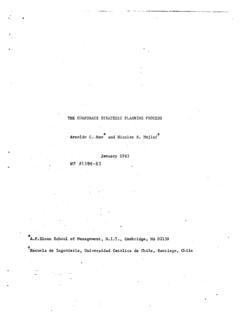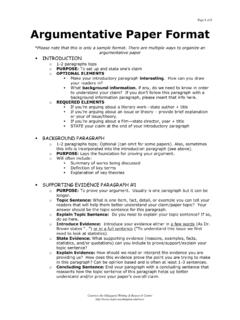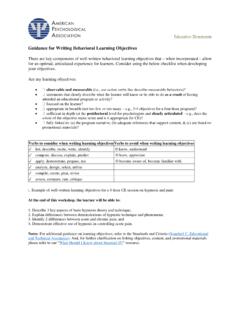Transcription of Writing effective policy memos
1 Water & Sanitation Infrastructure Planning Spring 2004 Writing effective policy memos What is a policy memo? A policy memo is a document that provides analysis and/or recommendations for a particular audience regarding a particular situation or problem. A well-written policy memo reflects attention to purpose; it is well organized; and it has a clear, concise style. Determining and responding to your audience In most cases, you will know the audience for your work because (1) you have been hired by that individual or organization or (2) your instructor provides that information to you. Think carefully about the needs and expectations of your audience. For example, if your audience is an elected official seeking analysis on a highly technical matter, you should generally assume that the official lacks substantial technical expertise.
2 You will need to define technical terms and provide enough background about the situation you are discussing that such a lay audience can grasp your arguments. On the other hand, if you are Writing for a technically trained audience, you will waste time and energy providing background information that your readers already know. Organizing an effective policy memo Introduction One distinguishing characteristic of a policy memo is that a summary of the document s conclusion(s) and recommendation(s) is placed right at the beginning of the memo. Remember that the purpose of the document is generally to provide your audience advice about a particular decision, project, or policy stance. Thus, you open the memo by summarizing the problem or situation about which you are Writing , and by providing a very brief summary of the conclusions/recommendations you have reached during your analysis.
3 The rest of the memo is designed to support the conclusions or recommendations you present. Background Keeping in mind that different audiences need different amounts of background information (see above), follow your introduction with a concise summary of any historical or technical that your audience needs to understand the arguments you are building. (It may be that no background information is needed at all.) Supporting arguments or analysis Once you have set the stage for your audience, show how this information leads logically to the conclusions/recommendations you have provided. 1 Water & Sanitation Infrastructure Planning Spring 2004 Style and format Your ideas will be no more meaningful to the reader of your memo than you are able to make them. Meaning is not just embellished by style; rather, the two must function together.
4 Muddled Writing reflects hazy thinking. Your prose should be simple, clear, and easy to read; you will confuse, not impress, your readers with sophisticated vocabulary. Your reader should be able to describe your conclusions and the general arguments you used to reach them after only one reading of your memo. Some tips on achieving an effective Writing style: (1) Choose the simplest words available to express your ideas. When discussing technical information, avoid the use of jargon--or at least define your terms clearly. (2) Make your sentences active ; avoid phrases such as there are or it is. (3) Use one paragraph to develop one idea or argument. Make that idea or argument explicit within the first one or two sentences of the paragraph. (4) PROOFREAD CAREFULLY. Don t distract your readers from the content of your memo with poor spelling or grammar.
5 The format of the memo should be as follows: (1) memos must be typed on X 11 or A4 paper with margins of one inch on all sides. (2) Paragraphs should be single-spaced and should be separated by a double space. (3) You may use any standard conventions for the layout of your memo, including numbering, bullets, indentation, etc. Do address the memo to your audience at the top of the page. See the attached sample for a suggested layout. Length The length of your policy memo assignment will be announced in class. Do not exceed this length limit! I am enforcing this rule for several reasons: (1) I assume that you will continue to write persuasive documents for clients and/or colleagues in the future. Like you, most of these people are busy. They rarely have time to review lengthy documents; these generally wind up unread in a filing cabinet or waste basket.
6 I m hoping to help you craft documents that are concise and of use to your clients or colleagues. (2) Confining yourself to a particular page limit encourages careful editing, establishing priorities, and paring your arguments down. In general, these practices also improve the flow and impact of your Writing . (3) Tightly written policy memos have a much better chance of influencing others toward a particular point of view. 2 Water & Sanitation Infrastructure Planning Spring 2004 Getting help I strongly recommend that you exchange your memos with other students in the class for proofreading and editing before you submit them. You can help one another with suggestions for clarity and content of your assignments. 3 Water & Sanitation Infrastructure Planning Spring 2004 M E M O R A N D U M TO: Dr.
7 Jane Doe, President Commission for Economic Sustainability FROM: David R. Ortiz, Analyst DATE: 7 October 1995 RE: Fuelwood management in Country Central Introduction The situation regarding fuelwood availability in Country Central is not yet at a crisis stage. Forests and arable land are readily available for use by the people. Deforestation is minimal compared to our neighboring counties. Yet economic conditions force the majority of the fuelwood to be collected illegally. I propose three major reforms to alleviate the problem of illegal fuelwood collection. First, we should offer individual communities small plots of forest for tenuring. Second, we should establish a network of regional fuelwood management offices to monitor the illegal trade of fuelwood, to encourage fuel efficiency, and to offer technical assistance for the sustainable use of tenured forests.
8 Third, a system of forest plantations should be developed to ensure future fuelwood supplies. Current land tenure situation in County Central Residents will continue to collect fuelwood illegally until they are otherwise guaranteed a supply. Land tenure offers the beneficiaries a direct reimbursement for their efforts. A number of key points support a system of land tenure: (1) The rural population does not have a financial means to purchase land at this time. Foreign ownership as well as ownership by the wealthy of County Central could lead to limited access to forests for the poor. This maldistribution of forest resources could have long term economic effects. (2) Land ownership means power. With recent government changes, we cannot afford to unleash this power to the people at this time. Actual ownership of the land should remain in the hands of the government.
9 (3) A system of tenure allows for better government regulation over changes in the forest resource base. Regulation of private forest lands with our limited work force would be impossible. In lieu of efficiency concerns, a system of community tenured regions would better accommodate current circumstances. The state forest should be divided into regions, each village or community having an assigned region. The concept of a community region is more realistic than individual tenure due to the unmanageable number of technicalities which would be encountered. Ecological impacts are location specific. These regions should be monitored by regional fuelwood management offices. Regional fuelwood management offices Management of the harvests of fuelwood will require local regulation. Your proposal should include the establishment of regional fuelwood management offices to facilitate the transition 4 Water & Sanitation Infrastructure Planning Spring 2004 from an illegal market to legal and organized cooperation.
10 The regional offices will have the following roles: (1) Report and regulate the flow of illegal fuelwood to the central government office so that regulations can be modified for improved efficiency; (2) Instruct villagers on maximizing use of fuelwood products by encouraging use of efficient stoves and kilns; (3) Instruct villagers on proper forest management for long-term goals of sustainability. This instruction could also include the role of proper management in erosion control and watershed protection. The regional fuelwood management offices should include a number of representative groups. Involvement of the local community is a requirement for success. Local farmers and leaders know the region, its customs and its people. In addition, an administrator from our government should be available to act as a liaison and to provide a political update on the situation.











